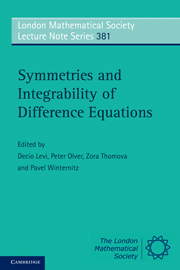Book contents
- Frontmatter
- Contents
- List of figures
- List of contributors
- Preface
- Introduction
- 1 Lagrangian and Hamiltonian Formalism for Discrete Equations: Symmetries and First Integrals
- 2 Painlevé Equations: Continuous, Discrete and Ultradiscrete
- 3 Definitions and Predictions of Integrability for Difference Equations
- 4 Orthogonal Polynomials, their Recursions, and Functional Equations
- 5 Discrete Painlevé Equations and Orthogonal Polynomials
- 6 Generalized Lie Symmetries for Difference Equations
- 7 Four Lectures on Discrete Systems
- 8 Lectures on Moving Frames
- 9 Lattices of Compact Semisimple Lie Groups
- 10 Lectures on Discrete Differential Geometry
- 11 Symmetry Preserving Discretization of Differential Equations and Lie Point Symmetries of Differential-Difference Equations
10 - Lectures on Discrete Differential Geometry
Published online by Cambridge University Press: 05 July 2011
- Frontmatter
- Contents
- List of figures
- List of contributors
- Preface
- Introduction
- 1 Lagrangian and Hamiltonian Formalism for Discrete Equations: Symmetries and First Integrals
- 2 Painlevé Equations: Continuous, Discrete and Ultradiscrete
- 3 Definitions and Predictions of Integrability for Difference Equations
- 4 Orthogonal Polynomials, their Recursions, and Functional Equations
- 5 Discrete Painlevé Equations and Orthogonal Polynomials
- 6 Generalized Lie Symmetries for Difference Equations
- 7 Four Lectures on Discrete Systems
- 8 Lectures on Moving Frames
- 9 Lattices of Compact Semisimple Lie Groups
- 10 Lectures on Discrete Differential Geometry
- 11 Symmetry Preserving Discretization of Differential Equations and Lie Point Symmetries of Differential-Difference Equations
Summary
This series of lectures was based on the textbook with A. Bobenko:
A. I. Bobenko, Yu. B. Suris, Discrete Differential Geometry: Integrable Structure. Grad. Studies in Math., vol. 98. Providence, RI: Amer. Math. Soc., 2008. This textbook contains an extensive bibliography.
The preliminary version of the book is available online at arXiν:math.DG/ ∅5∅4358.
The lectures aimed at giving an introduction to the main ideas of (an integrable part of) discrete differential geometry. I am grateful to organizers of the Summer School on Symmetries and Integrability of Difference Systems (Montréal, 2008) for inviting me to give these lectures and for the financial support.
Discrete differential geometry (DDG) is a new field presently emerging on the border between differential and discrete geometry. It develops discrete analogues and equivalents of notions and methods of differential geometry of smooth curves, surfaces etc. The smooth theory appears in a limit of the refinement of discretizations. Current interest in this field derives not only from its importance in pure mathematics but also from its relevance for other fields, like computer graphics, architectural design and numerics. Integrable differential geometry deals with parametrized objects (surfaces and coordinate systems) described by integrable differential equations. As integrability attributes one counts traditionally: zero curvature representations, transformations with remarkable permutability properties, hierarchies of commuting flows etc. Development of DDG led, somewhat unexpectedly, among other things, to a better understanding of the very notion of integrability.
- Type
- Chapter
- Information
- Symmetries and Integrability of Difference Equations , pp. 259 - 291Publisher: Cambridge University PressPrint publication year: 2011
- 1
- Cited by

